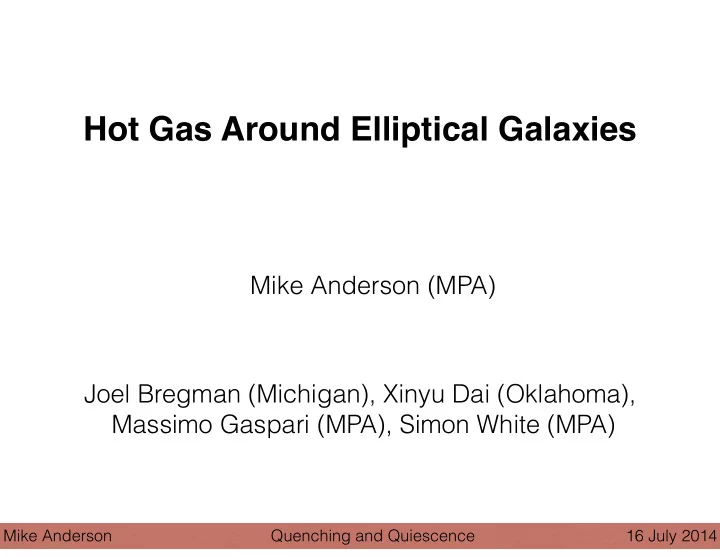

Hot Gas Around Elliptical Galaxies Mike Anderson (MPA) Joel Bregman (Michigan), Xinyu Dai (Oklahoma), Massimo Gaspari (MPA), Simon White (MPA) Mike Anderson Quenching and Quiescence 16 July 2014
Outline Very brief summary of properties of hot halos � Why do ellipticals have hot halos? � Connecting hot halos in galaxies, groups, and clusters Mike Anderson Quenching and Quiescence 16 July 2014
Hot Halo Basic Properties Total X-ray luminosity Extended emission only Anderson et al. 2013 Ellipticals seem to have higher L X than spirals: because of morphology? M/L ratio? halo mass? Mike Anderson Quenching and Quiescence 16 July 2014
Hot Halo Basic Properties Anderson et al. 2013 Assuming: Z = 0.3 Zsun, kT = 0.2 keV Mike Anderson Quenching and Quiescence 16 July 2014
Hot Gas Baryon Budgets Hot gas surface brightness profile Enclosed Mgas profile Anderson and Bregman 2014 AB14 NGC 720 H11 H06 bkg steepening? Rvir Surface brightness profiles are typically fairly well-behaved But can be difficult to measure at large radii Currently we must rely on large (&uncertain) extrapolations Mike Anderson Quenching and Quiescence 16 July 2014
Temperature Profiles of Hot Halos Competition between heating and cooling • T slowly declines with r for galaxies • flat-ish for massive galaxies • cool core for galaxy groups Diehl and Statler 2008 Mike Anderson Quenching and Quiescence 16 July 2014
LX - LK Relation: � Diversity in Hot Gas Properties Mulchaey and Jeltema 2010 effects of feedback? galactic dynamics? environment? Mike Anderson Quenching and Quiescence 16 July 2014
Why do ellipticals have hot gaseous halos? Internal origin theories: ISM converted to hot halo via dynamical heating + SNe (Mathews and Baker 1971; Conroy et al. 2014) * and/or * AGN feedback (Silk and Rees 1998, Springel et al. 2005) � External origin theories: Accretion shocks (White and Rees 1978) * or, for cluster galaxies: * Intracluster medium Mike Anderson Quenching and Quiescence 16 July 2014
Generally internal origin is favored: NGC 507 But low-metallicity accreted gas cannot totally be ruled out: Kim and Fabbiano 2004 Crain et al. 2013 Mike Anderson Quenching and Quiescence 16 July 2014
Rotation seems to matter -> dynamical heating? Salzi et al. 2013 Environment could also be important though… Will come back to this later in the talk Mike Anderson Quenching and Quiescence 16 July 2014
A Sample of Locally Brightest Galaxies Anderson et al. 2014 (in prep) N = 259 759 Mike Anderson Quenching and Quiescence 16 July 2014
Pressure - Mass relation stacked SZ signal (from Planck) Planck Collaboration et al. 2013 Mike Anderson Quenching and Quiescence 16 July 2014
11.9-12.0 11.8-11.9 11.7-11.8 11.6-11.7 1.5 Mpc 1.5 Mpc 1.25 Mpc 1.0 Mpc Anderson et al. 2014 (in prep) log M* = 11.6 -11.7 0 0.2 0.4 0.6 0.8 1 1.2 0 0.2 0.4 0.6 0.8 1 1.2 1.4 1.6 0 0.5 1 1.5 2 2.5 3 3.5 4 0 1 2 3 4 5 6 7 8 11.5-11.6 11.4-11.5 11.3-11.4 11.2-11.3 1.0 Mpc 0.75 Mpc 0.5 Mpc 0.5 Mpc 0 2 4 6 8 10 12 2 4 6 8 10 12 14 2 3 4 5 6 7 8 9 10 5 6 7 8 9 10 11 12 13 11.1-11.2 11.0-11.1 10.9-11.0 10.8-10.9 0.5 Mpc 0.5 Mpc 0.5 Mpc 0.5 Mpc log M* = 10.8 -10.9 8 10 12 14 16 18 10 12 14 16 18 20 22 17 18 19 20 21 22 23 24 25 17 18 19 20 21 22 23 24 25 26 27 28 10.7-10.8 10.6-10.7 10.5-10.6 10.4-10.5 0.5 Mpc 0.5 Mpc 0.5 Mpc 0.5 Mpc 18 19 20 21 22 23 24 25 26 27 28 17 18 19 20 21 22 23 24 25 26 14 15 16 17 18 19 20 21 22 23 11 12 13 14 15 16 17 18 19 20 21 10.3-10.4 10.2-10.3 10.1-10.2 10.0-10.1 0.5 Mpc 0.5 Mpc 0.5 Mpc 0.5 Mpc 10 11 12 13 14 15 16 17 7 8 9 10 11 12 13 14 15 5 6 7 8 9 10 11 4 4.5 5 5.5 6 6.5 7 7.5 8 8.5 9 Mike Anderson Quenching and Quiescence 16 July 2014
LX, 500 - Stellar Mass Relation galaxies groups clusters Mike Anderson Quenching and Quiescence 16 July 2014
LX, 500 - Stellar Mass Relation galaxies groups clusters Low-mass X-ray binaries Mike Anderson Quenching and Quiescence 16 July 2014
Same scatter as LX-LK relation! Intrinsic scatter: comparable to LX - LK relation for galaxies (but these are all centrals!) decreases significantly for groups larger again for clusters (due to steep M*-Mhalo relation) Mike Anderson Quenching and Quiescence 16 July 2014
X-ray Luminosity (0.15-1.0 R500 annulus) Hot halos around (almost) all galaxies with log M* ≈ 11.0 Mike Anderson Quenching and Quiescence 16 July 2014
LX - M* relation (measured from log M* = 11.0 - 12.0) Preliminary LX = L 0 x (bolo_corr) x (M* /1e11) α Mike Anderson Quenching and Quiescence 16 July 2014
Estimate effective Mhalo for each bin…. Mike Anderson Quenching and Quiescence 16 July 2014
… fit for LX - M500 relation LX, bol = L 0 x bolo_corr x E(z) 7/3 x (M/M0) α Preliminary α Self-similar: α = 4/3 Galaxy clusters: α = 1.7-2.0 log L 0 (due to non-gravitational heating) Mike Anderson Quenching and Quiescence 16 July 2014
… fit for LX - M500 relation Preliminary Mike Anderson Quenching and Quiescence 16 July 2014
Conclusions • Isolated ellipticals do not seem to have their missing baryons in the hot halo � • Elliptical galaxies have diverse temperature profiles and LX � • Simple power-law relations hold from clusters to galaxies: • M* - Y • M* - LX • M500 - LX � • L-M relations are consistently steeper than self-similar Mike Anderson Quenching and Quiescence 16 July 2014
Recommend
More recommend